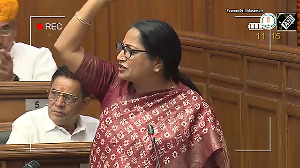'Ideally, what we target is 35-40 per cent ULIP; 30-35 per cent non-par; 15-20 per cent from par; and the balance we try to do from annuities and others.'

Following its Q3 earnings, Axis Max Life Insurance said its board approved a roadmap that envisages the listing of Axis Max Life through the merger of Max Financial Services into Axis Max Life.
Prashant Tripathy, MD & CEO, Axis Max Life Insurance, in a conversation with Subrata Panda and Aathira Varier/Business Standard, spoke about the listing plan and discussed the company's performance.
What is the merger plan with Max Financial Services and the subsequent listing plan of Axis Max Life Insurance?
We aim to merge the two entities - Max Financial Services and Axis Max Life Insurance - and we believe that the recommendation in Section 35 of the new insurance Bill will support this effort.
Ultimately, once the Bill is passed and all necessary approvals for the merger are obtained, the goal is for Axis Max Life Insurance to become a listed entity.
However, this process will take some time. Depending on the approval timeline, it may span a few quarters.
We have already initiated the discussion internally.
We will file for approval and hopefully, with the clarity in the Act, the insurance regulator's approval will not take long.
However, the entire merger process of going through the National Company Law Tribunal (NCLT), would take anywhere between four to six quarters.
How do you view the performance of the company in Q3?
In Q3, we rebranded ourselves as Axis Max Life Insurance. While the brand Max Life Insurance was strong in large cities, we wanted to make sure that brand awareness and consideration improved in Tier-II and Tier-III cities.
A large part of our sales happens through Axis Bank, so having the same brand will facilitate and create positive momentum in the minds of the bank sellers.
In the first nine months, we have grown at 25 per cent versus private sector growth of 19 per cent and overall industry growth of 14 per cent.
We are gaining market share as we go along.
We are expanding our presence, and a large part of our growth is actually coming from our (proprietary) channels.
Our banking channels have also performed reasonably well.
Our assets under management (AUM) are now touching Rs 1.72 trillion.
And, for the second year in a row, growth in the number of policies is around 20 per cent.
The value of new business (VNB) margin stood at 23.2 per cent in Q3FY25.
This could have been a bit better. We are making efforts to ensure that we rebalance our product mix in a manner that our margin is close to 25 per cent by the end of the year.
Was the margin hit because of the new surrender value norms or because of the ULIP-heavy product mix?
Last year, in Q3, our margin was 27.2 per cent, and this quarter it came in at 23.2 per cent. So, of the 4 per cent delta that you see, of that, about 100 basis points (bps) is the impact of the new surrender guidelines.
The remaining 300 bps hit is because of the product mix. We are writing more ULIP and less non-par.
The answer lies in writing more protection, writing more variants which are high-margin generation.
What would you want your product mix to be?
Ideally, what we target is 35-40 per cent ULIP; 30-35 per cent non-par; 15-20 per cent from par; and the balance we try to do from annuities and others.
That's typically the mix with which we operate. Around 15 per cent protection annuity on a retail basis.
About 15 per cent from par and 70 per cent from these two categories.
How have you structured your commissions following implementation of the new surrender value norms?
The commission structure depends on what kind of distributor and what kind of persistency profile they have.
If the persistency is very high, then we have in some cases clawed back.
If the persistency is low, then we have reduced the commissions.
But we have also created a gradient that if persistency improves, the distribution partner will get paid more. So, it is persistence-linked.
How much has the internal rate of return (IRR) changed?
It has changed marginally. Across all cohorts, we have made changes. But it varies by different products and categories.
For example, we have not made any changes in participating products and ULIPs.
However, we have made changes in some cohorts on product designs in non-par to the extent of about 15-20 basis points.
Would you look at entering the health insurance space?
We see health as a very attractive segment. Large part of health is also done by agents. We have a very strong agency workforce already.
So, that's one area that will be a strategic item for us. We are going to work on it as more clarity emerges.
We are not progressing with other general insurance opportunities like car insurance because we don't see adjacencies or contiguities with respect to those lines.
Is there any plan to bring in another strategic partner into the company?
That's not the plan. It will continue to be a joint venture. When we list, we will become an independent organisation. That's the direction we are taking.
There is no proposal to have any other strategic partners come through.
Feature Presentation: Aslam Hunani/Rediff.com












 © 2025
© 2025